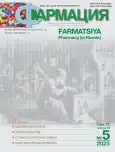Development and implementation of a methodology for integrated assessment and prediction of non-compliance risk for HIV-infected patients
- Authors: Petrov A.G.1, Glembotskay G.T.2, Khoroshilova O.V.1, Semenikhin V.A.1
-
Affiliations:
- Kemerovo State Medical University
- I.M. Sechenov First Moscow State Medical University (Sechenov University)
- Issue: Vol 72, No 5 (2023)
- Pages: 52-59
- Section: Organization and economy
- URL: https://journals.eco-vector.com/0367-3014/article/view/568113
- DOI: https://doi.org/10.29296/25419218-2023-05-07
- ID: 568113
Cite item
Abstract
Introduction. In the current global situation, HIV-infected persons are still a vulnerable group of the population, therefore it is extremely important that effective preventive measures are developed and taken to ensure their well-being. An integral part of monitoring the effectiveness of preventive measures is the importance of understanding the essence and correct assessment of the risk of non-compliance. A scientifically based assessment of this risk and its prediction can protect HIV-infected people from further complications. This paper presents a method of integral assessment and prediction of the risk of non-compliance with the patient's treatment regimen as a way to control the effectiveness of preventive measures for HIV-infected patients, based on the results of a survey of HIV-infected patients for adherence to treatment and based on the proposed methodological approach.
Objective: to develop a methodological approach to predicting the risk of non-compliance in patients with HIV infection.
Material and methods. A survey was conducted of 200 patients treated at the State Medical Institution "Kuzbass Center for the Prevention and Control of AIDS". The methodological approach to predicting the risk of non-compliance with the treatment regimen by HIV-infected patients is based on taking into account a set of factors affecting the results of therapy of HIV-infected patients.
Results. It has been established that patients with HIV infection, as a rule, do not follow many recommendations of doctors on compliance with the treatment regimen, which significantly reduces the level of adherence to pharmacotherapy. Therefore, the proposed methodology for assessing patients' non-compliance with the treatment regimen and determining risk ranges are aimed at monitoring the effectiveness of preventive measures and increasing its practical significance.
Conclusion. In the evaluation process, a fairly low level of compliance with the treatment regimen was established by patients (the value of the HIV-infected patients' treatment adherence index was 52.5%), which indicates the need to eliminate risk factors for non-compliance by adopting special requirements.
Full Text
About the authors
A. G. Petrov
Kemerovo State Medical University
Author for correspondence.
Email: mefc@mail.ru
ORCID iD: 0000-0001-9543-1134
доктор фармацевтических наук, доцент, профессор кафедры фармации
Russian Federation, Voroshilova str., 22a, Kemerovo, 650056G. T. Glembotskay
I.M. Sechenov First Moscow State Medical University (Sechenov University)
Email: glembotskaya_g_t@staff.sechenov.ru
ORCID iD: 0000-0002-4193-8973
доктор фармацевтических наук, профессор, профессор кафедры организации и экономики фармации Института фармации им. А.П. Нелюбина
Russian Federation, Trubetskaya str., 8, p. 2, Moscow, 119991O. V. Khoroshilova
Kemerovo State Medical University
Email: olgakhorosh77@yandex.ru
ORCID iD: 0000-0001-6607-8431
кандидат фармацевтических наук, ассистент кафедры фармации
Russian Federation, Voroshilova str., 22a, Kemerovo, 650056V. A. Semenikhin
Kemerovo State Medical University
Email: viansem@yandex.ru
ORCID iD: 0000-0003-0517-2154
доктор медицинских наук, профессор кафедры факультетской терапии, профессиональных болезней и эндокринологии
Russian Federation, Voroshilova str., 22a, Kemerovo, 650056References
- On the state of sanitary and epidemiological welfare of the population in the Russian Federation in 2020: State Report. Moscow: Federal Service for Supervision of Consumer Rights Protection and Human Well-being, 2021; 256.
- On the state of sanitary and epidemiological welfare of the population in Kuzbass in 2021: State report. Kemerovo, 2022; 280.
- Petrov A.G., Filimonov S.N., Khoroshilova O.V., Semenikhin V.A., Chernykh N.S. Epidemiological aspects of the incidence of HIV infection in the Russian Federation and Kuzbass. Medicine in Kuzbass. 2022; 21 (4): 78–86.
- Petrov A.G., Abramov N.V., Sedykh D.Yu., Kashtalap V.V. Methodological approach to predicting the risk of noncompliance in patients with myocardial infarction. Complex problems of cardiovascular diseases.t2021;10(4): 48-57. doi: 10.17802/2306-1278-2021-10-4-48-57
- Petrov A.G., Semenikhin V.A., Glembotskaya G.T., Knysh O.I., Khoroshilova O.V., Marciyash A.A. Pharmaceutical sanology as a strategic resource for the prevention of occupational diseases: monograph. Kemerovo, 2020; 271.
- Pokrovsky V.V., Yurin O.G., Kravchenko A.V., Belyaeva V.V., Buravtsova V.V., Deulina M.O. et al. Recommendations for the treatment of HIV infection and related diseases, chemoprophylaxis of HIV infection. Epidemiology and infectious diseases. Current issues. 2019; 9 (4): 1–87.
- Petrov A.G., Abramov N.V., Kashatalap V.V., Glembotskaya G.T., Knysh O.I., Sedykh D.Yu., Khoroshilova O.V. Organizational and methodological foundations for improving medical and pharmaceutical care for patients with myocardial infarction: monograph. Kemerovo, 2022; 277.
- Petrov A.G., Knysh O.I., Semenikhin V.A., Petrov G.P., Khoroshilova O.V. Organizational and methodological foundations for improving specialized pharmaceutical care for coal industry workers: monograph. Kemerovo: Kuzbassvuzizdat, 2019; 255.
- Shigan E.N. Application of modern mathematical approaches and numerical means in healthcare. M.: TSOLIUV, 1973; 41.
- Shigan E.N. Methods of forecasting and modeling in socio-hygienic research. M.: Medicine, 1986; 155.
Supplementary files





